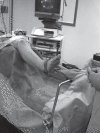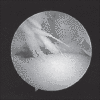Ankle arthroscopy in children
- PMID: 21477438
- PMCID: PMC3291142
- DOI: 10.1308/003588411X564005
Ankle arthroscopy in children
Abstract
Introduction: Arthroscopy of the ankle has gained acceptance as a procedure for diagnosing and treating chronic and post-traumatic ankle problems. The senior author's perception is that magnetic resonance imaging (MRI) under-diagnoses anterior soft tissue impingement lesions in children. The purpose of this study was retrospectively to analyse the outcome of ankle arthroscopy in the paediatric age group.
Patients and methods: Between March 2005 and September 2007, 23 children underwent ankle arthroscopy for post-traumatic pathology. The indications for arthroscopy were failure of non-operative treatment for at least 12 weeks or a grade 3 or 4 osteochondral defect (OCD) on imaging.
Results: At arthroscopy, OCDs were visualised in 12 cases and impingement lesions were seen in 17 ankles. MRI was performed in 8 of these 12 cases and only 1 suggested the possibility of an impingement lesion. Of the 17 cases of impingement seen on arthroscopy, 12 reported mechanical symptoms preoperatively and 4 were unstable on examination under anaesthetic. Eighteen of the twenty-three patients had complete relief of symptoms at 3 months. Eighteen children who were evaluated at one-year follow up had a mean American Orthopaedic Foot and Ankle Society score of 87. 5 (range: 49-100).
Conclusions: Ankle arthroscopy has a successful outcome in paediatric patients and the results are comparable with those reported in adult series. MRI was found to be insensitive for the diagnosis of soft tissue impingement of the ankle.
Figures
Comment in
-
Ankle arthroscopy in children.Ann R Coll Surg Engl. 2012 Apr;94(3):216; author reply 216-7. doi: 10.1308/003588412x13171221500141. Ann R Coll Surg Engl. 2012. PMID: 22507738 Free PMC article. No abstract available.
References
-
- O'Loughlin PF, Heyworth BE, Kennedy JG. Current concepts in the diagnosis and treatment of osteochondral lesions of the ankle. Am J Sports Med. 2010;38:392–404. - PubMed
-
- Fong DT, Hong Y, et al. A systematic review on ankle injury and ankle sprain in sports. Sports Med. 2007;37:73–94. - PubMed
-
- van Dijk CN, van Bergen CJ. Advancements in ankle arthroscopy. J Am Acad Orthop Surg. 2008;16:635–646. - PubMed
-
- Higuera J, Laguna R, et al. Osteochondritis dissecans of the talus during childhood and adolescence. J Pediatr Orthop. 1998;18:328–332. - PubMed
Publication types
MeSH terms
LinkOut - more resources
Full Text Sources
Medical




